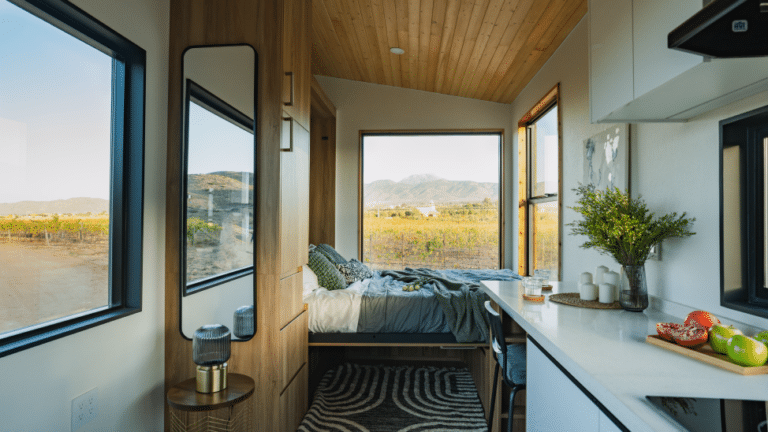ADUs:
What Are They and What You Should Know About Financing One
Brandon Hustlar June 21st 2024
What is an ADU and why should you build one?
Accessory Dwelling Units, commonly known as ADUs, are small living units that are attached or detached from a single-family home. They can be used as a rental unit, in-law unit, or even just extra space for guests.
Additionally, ADU housing can be a great way to accommodate and give privacy to extended family members or friends who visit frequently.
Benefits of an ADUs:
Rental Income Potential: First-time buyers can generate additional income by renting out the ADU. This additional revenue stream can help offset mortgage and maintenance costs.
Increased Property Value: ADUs can boost the overall value of your property. This can be advantageous when you decide to sell your home in the future.
Multigenerational Living: ADUs provide space for extended family or guests. It’s an ideal solution for accommodating family members while maintaining privacy.
Flexibility: ADUs can serve various purposes, such as a home office, studio, or personal space. They can adapt to your changing needs.

Types of ADUs:
ADUs come in various forms, including:
Attached ADUs
Attached ADUs are connected to the primary residence, such as converted basements, garages, or additions.
Detached ADUs
Detached ADUs are standalone structures located on the same property as the primary residence, such as backyard cottages, converted garages, or modular units.
Junior ADUs
Junior ADUs are smaller units located within or attached to the primary residence, typically with limited kitchen or bathroom facilities.
When budgeting for an ADU, consider everything: labor, materials, permits and furniture. Budgeting sensibly will prevent you from having financial issues in the middle of a project. Examine your possibilities for funding, such as grants or loans; for example, the CALHFA 40k ADU Grant (Keep in mind it is paused till further noticed). And for loans, a HELOC, or second mortgage are good options.

Overall, building an Accessory Dwelling Unit (ADU) on your property is a promising adventure that can enhance your living space, generate rental income, and increase property value. By carefully evaluating the benefits and finances for homeowners can ensure a smooth and successful ADU project.
With thoughtful planning and attention to detail, you can unlock the full potential of your property with an ADU, creating a functional and profitable addition that meets your needs.
Factors to keep in mind as you investigate financing you ADU
The cost of building an ADU can vary based on several factors, including the project’s size, scope, and location. Different cities may have varying permit fees and construction costs, so it’s crucial to consider these aspects.
The most substantial expense in building an ADU is typically the construction costs. This includes materials, labor, and contractor fees. The size and complexity of the ADU, as well as the quality of materials used, will significantly impact these costs.
Your contractor can also help obtain the necessary permits for building an ADU, which comes with fees. These fees can vary depending on the city and type of permits required.

Connecting the ADU to utilities like water, sewer, and electricity also comes with costs. Depending on the existing infrastructure on the property, these connections may require additional work and expenses.
Consider setting aside a contingency fund for unexpected expenses that may arise during construction. Unforeseen issues or changes to the original plan can impact your budget, and having a contingency fund helps manage these situations.
At Homeplex we can provide you with different options
Some Types of financing options for your ADU HELOC:
A home equity line of credit is an alternative option for financing an ADU. Similar to a home equity loan, a HELOC allows homeowners to leverage the equity in their property. However, a HELOC functions more like a credit card with a revolving line of credit.
Homeowners can borrow as needed, paying interest only on the amount used. This flexibility can be beneficial for managing construction costs, allowing homeowners to draw funds incrementally as the ADU project progresses. It may also help those who aren’t quite sure what their construction costs are and may need additional funds to complete the project.
While HELOCs often come with variable interest rates, offering flexibility, borrowers should be mindful of potential fluctuations in interest payments.
Second mortgage: A second mortgage is a lien that’s taken against a house when a new loan is issued and a first loan is still outstanding. Second mortgages are separate loans that have their own applications, closing costs and monthly payments.
Second mortgages allow homeowners to borrow against the equity in their homes without having to refinance the first mortgage. Using a second mortgage, you borrow up to 85% of your total home value (minus the amount owed on a first mortgage) for as little as 2 percentage points over prime rate, plus closing costs. Keep in mind that lenders expect you to have about 20% equity in your home before they’ll approve a second mortgage.

Overall, Financing an ADU can be challenging, but understanding your options can make the process more manageable. Whether you’re leveraging a home equity line of credit (HELOC), obtaining a second mortgage, or seeking grants like the CalHFA 40K Grant, each financing method offers distinct advantages. HELOCs provide flexible, incremental funding, ideal for uncertain construction costs. Second mortgages, although separate from your primary mortgage, allow substantial borrowing against home equity. Regardless of the financing route, consider factors like construction costs, permit fees, and utility connections. With careful planning and the right financing, building an ADU can enhance your property value, generate rental income, and offer versatile living solutions.
Got more questions? Book a free call with one of our experts.
Prefab Homes
hello@homeplex.net
(424) 428-8000
145 W Broadway
Long Beach, CA 90802
DRE #02186195
© 2025. All rights reserved. HOMEPLEX, The New American Dream are registered trademarks of HOMEPLEX, INC.


